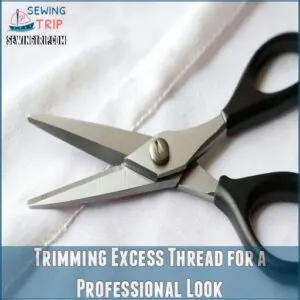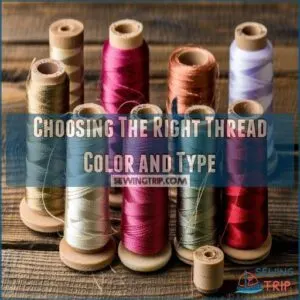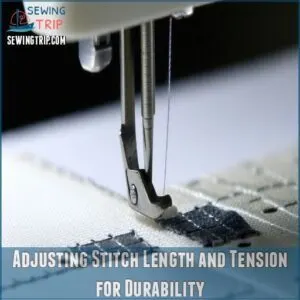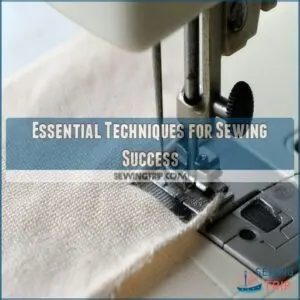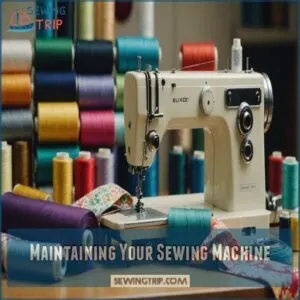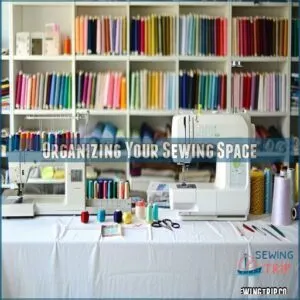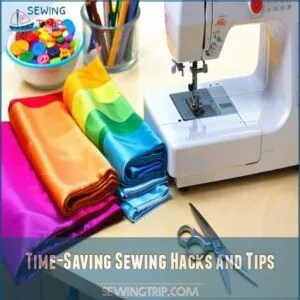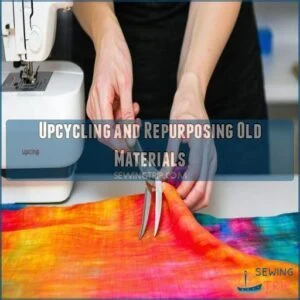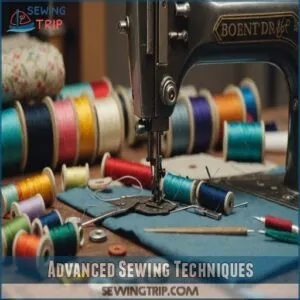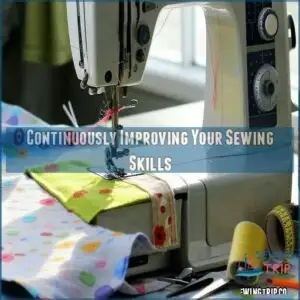This site is supported by our readers. We may earn a commission, at no cost to you, if you purchase through links.
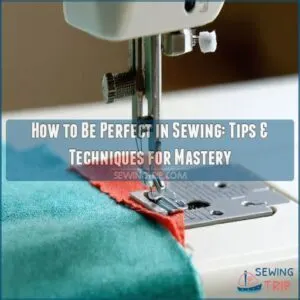
Make sure your machine’s tension and stitch length are set right—think of it like tuning a guitar for the perfect harmony.
Always choose the right thread and fabric.
Your secret weapon? Press as you sew for crisp seams—it’s like ironing for instant style points.
Trim threads for a professional look, and remember, a clean machine is a happy machine.
Don’t get tangled in the threads of perfectionism; practice makes perfect.
Intrigued? There’s more to uncover on this crafty journey toward sewing greatness.
Table Of Contents
- Key Takeaways
- Mastering Sewing Fundamentals
- How to Sew Perfectly Every Time
- Essential Techniques for Sewing Success
- Choosing The Right Fabric and Thread
- Maintaining Your Sewing Machine
- Organizing Your Sewing Space
- Time-Saving Sewing Hacks and Tips
- Upcycling and Repurposing Old Materials
- Advanced Sewing Techniques
- Continuously Improving Your Sewing Skills
- Frequently Asked Questions (FAQs)
- Conclusion
Key Takeaways
- Master the basics by ensuring your sewing machine is in top shape, understanding the importance of choosing a user-friendly machine with simple dials and settings, such as those found in guides on how to sew at home, adjusting stitch length and tension like tuning a guitar for perfect harmony.
- Always press seams as you sew for a neat appearance, trim excess threads, and select the right fabric and thread color for a professional look.
- Organize your sewing space with clear containers and sharp tools, using binder clips for thick fabrics and magnets to pick up dropped pins.
- Continuously improve your skills by embracing mistakes as learning opportunities, experimenting with fabrics, and staying motivated within a dedicated sewing area.
Mastering Sewing Fundamentals
To master sewing fundamentals, focus on pressing seams and selecting the right thread color to achieve a professional look.
Keep threads neat by trimming excess threads after sewing. Remember, if your threads take a road trip across your fabric, they’re definitely lost.
Pressing Seams and Fabric for a Neat Appearance
Pressing seams is like giving your fabric a mini spa day—essential for that polished look.
Use ironing tools wisely based on your fabric types, and master pressing techniques to control seam allowances.
Aim for neat finishes by pressing along the fabric grain.
Remember, a well-pressed seam sets the stage for sewing perfection and adds a professional touch.
Trimming Excess Thread for a Professional Look
Let’s face it, those pesky loose threads can ruin even the most beautiful garment. A neat seam finish is key to looking like a pro!
Here’s how to trim threads like a sewing ninja:
- Use sharp scissors—dull ones snag and pull.
- Trim close to the fabric, but don’t cut the fabric itself.
- For hard-to-reach spots, try tiny thread snipping techniques with embroidery scissors.
- Always trim after you finish sewing each seam. It’s a small step for a huge improvement in your professional sewing look.
Choosing The Right Thread Color and Type
After tidying threads, pick the right thread color and type.
It’s like picking shoes: match fabric or go bold with contrasting thread for flair.
For decorative metallic thread options, check out metallic threads online.
Remember, thread thickness should match fabric weight.
A quick guide:
| Thread Type | Best For | Considerations |
|---|---|---|
| Cotton | Lightweight cotton | Not stretchy |
| Polyester | Stretch fabrics | Strong and flexible |
| Silk | Delicates | Luxurious yet costly |
| Nylon | Outdoor gear | Moisture-resistant |
| Metallic | Embellishments | Decorative touch |
Choose quality threads.
Adjusting Stitch Length and Tension for Durability
To stitch like a pro, pay attention to stitch length and tension settings.
It’s like tuning a guitar – get it wrong, and your seams may hit a sour note.
To adjust stitch length effectively, understanding the stitch length mechanism is important for a smooth operation.
- Stitch length: Choose shorter lengths for strong seams.
- Fabric weight: Adjust tension for thick or thin materials.
- Seam strength: Experiment with settings on scrap fabric.
How to Sew Perfectly Every Time
Perfecting your sewing techniques can shift your creations from homemade to high fashion. Building on those fundamentals, here’s how you can sew perfectly every time.
- Prepare Your Workspace: A good pair of sharp Fabric Scissors and keeping your sewing machine essentials organized will help you stay focused. A tidy space leads to fewer mistakes.
- Understand Your Machine: Knowing your sewing machine basics will save you from unnecessary stitches and headaches.
- Plan Your Project: Like a chef with a recipe, good sewing project planning makes sure precision. Double-check your measurements and fabric choices.
- Avoid Common Mistakes: Often, rushing leads to errors. Slow down and enjoy the process. Correct tension and stitch length adjustments will help avoid fabric puckering.
With the right mix of planning and practice, you’ll be on your way to sewing mastery!
Essential Techniques for Sewing Success
To achieve sewing success, focus on perfecting seam finishing techniques, mastering a variety of stitches, and handling different fabrics with confidence.
Imagine transforming your sewing projects from ordinary to extraordinary by simply tweaking your methods—your creations will thank you!
Seam Finishing Techniques for a Professional Finish
Stuck seams are no fun; mastering seam finishing transforms your projects.
Overcasting or serging keeps fabric edges tidy and fray-free.
Fancy a clean, professional look? Try blind hems or trim edges carefully.
Flat felled seams offer strength and style, perfect for jeans.
Keep it simple, guarantee durability, and give your creations that polished, store-bought vibe.
Mastering Different Stitches for Versatility
Ever tangled in a stitch mess?
Mastering stitch types boosts versatility.
Like a painter with brushes, each stitch has a purpose.
Knowing what are sewing stitches is key to choosing the right technique for your project.
- Running Stitch: Ideal for basting.
- Backstitch: Strong and durable, for seams.
- Zigzag Stitch: Prevents fraying, adding flair.
- Blanket Stitch: Perfect for edges, looks decorative.
Experiment and practice these techniques for creativity in every project.
Handling Various Fabrics With Ease
So, you’ve mastered different stitches? Awesome! Now, let’s tackle different fabrics.
Each fabric type—from delicate chiffon to sturdy denim—has its own personality.
Knowing the grain direction helps with even stitching.
Adjust your sewing machine settings with the help of a quality machine and routine maintenance for the best results, especially when working with a variety of fabric types, such as woven fabrics like linen. Adjust your sewing machine settings for fabric weight.
Using the right needle is key.
With practice, you’ll sew any fabric like a pro!
Choosing The Right Fabric and Thread
Choosing the right fabric and thread is like picking the last puzzle piece—it’s essential for a perfect fit.
Fabric properties, thread type, and color matching are all important considerations to make sure your sewing project turns out just right.
Understanding Fabric Properties and Selection
Mastering different stitches is important, but understanding fabric properties can make or break your sewing game.
Consider these fabric traits:
- Weight: Light fabrics float like a butterfly; heavy ones pack a punch.
- Texture: Soft, rough, or slippery?
- Care: Machine wash or delicate hand wash?
- Drape and Stretch: Does it flow or cling?
Get your fabric right, and success is within reach!
Selecting The Right Thread Material and Thickness
Choosing thread isn’t just picking a color; it’s about material and thickness.
Imagine this:
| Thread Type | Best For | Strength |
|---|---|---|
| Cotton | Light Fabrics | Medium |
| Polyester | Stretchy Fabrics | High |
| Nylon | Heavy Fabrics | Very High |
Matching the right thread to your fabric gives life to your sewing project, ensuring strength and durability. To choose the perfect thread, consider the fabric recommendations provided in your sewing pattern, such as those found in mastering sewing patterns, ensuring strength and durability.
Matching Thread Color to Fabric for a Clean Look
When matching thread to fabric, think of it like pairing wine with cheese—you’re aiming for harmony.
Use thread color that blends seamlessly for subtle seams.
Thread color matching tips: Hold thread against the fabric in different lights.
For adventurous designs, opt for contrasting threads that shout creativity.
Seam blending? Go monochrome and keep it sleek!
Maintaining Your Sewing Machine
Keeping your sewing machine in tip-top shape is like maintaining a smooth-running bicycle—regular cleaning and occasional tweaks make all the difference.
Change those dull needles, adjust tension as needed, and your fabric won’t look like it’s been through a wrestling match!
Regular Cleaning and Servicing for Optimal Performance
Keeping your sewing machine running smoothly isn’t just a nice-to-have—it’s a must!
Regular maintenance prevents common problems.
- Dust it off: After every project, remove lint and debris with a small brush.
- Oil the gears: Monthly oiling keeps things smooth. Check your manual.
- Service professionally: Schedule a yearly check-up for the best performance and longevity.
Changing Needles and Adjusting Tension
Regularly changing your sewing machine needle is key!
A dull needle, especially with thicker threads or tough fabrics, leads to skipped stitches and broken threads.
Match the needle size to your fabric type—too big or small causes problems.
Tension issues? Adjust your machine’s tension dial. Experiment to find the sweet spot for different thread thicknesses and fabrics. A little tweaking goes a long way for perfect stitches.
Troubleshooting Common Machine Issues
Running into machine noise or needle breakage can be frustrating. It’s like your sewing machine wants attention. Here are some quick fixes:
- Check bobbin tension: It may just need a slight adjustment.
- Look for skipped stitches: Re-thread the machine carefully.
- Handle thread jams: Clear and clean regularly.
- Prevent breakage: Use the right needle for fabric.
Organizing Your Sewing Space
Keeping your sewing space organized can make all the difference between crafting ease and chaotic clutter.
By ensuring your fabrics and tools are neatly stored and easily accessible, you’ll save both time and sanity on your next project.
Storing Fabrics and Notions for Easy Access
Think of fabric organization like sorting a candy jar.
Use vertical storage and drawer dividers to neatly stash your notions and fabrics.
Label everything, so you’re not playing hide-and-seek with your supplies.
When storing fabric, consider using a climate-controlled area and follow expert advice on how to store material to prolong its lifespan.
A touch of humor goes a long way—try storing by color or project type just for kicks.
| Storage Tip | Description |
|---|---|
| Vertical Storage | Maximizes space vertically |
| Drawer Dividers | Keeps small items organized |
| Color Coding | Easy identification |
| Labels | Quick access |
| Clear Containers | Visible storage solutions |
Keeping Scissors and Tools Sharp and Handy
Sharp scissors cut better, yet they’re like your favorite pair of jeans—handle with care for a long-lasting fit.
Sharpen them regularly and reserve them for fabric only.
Store your tools neatly; a magnetic strip keeps sewing needles and pins in order.
This simple organization makes sure every tool is ready, saving time and frustration during your creative projects.
Creating a Dedicated Sewing Area
After sharpening your tools, focus on crafting a dedicated sewing area.
Imagine this: a cozy nook with everything in reach.
For a seamless setup, explore sewing storage solutions online, such as sewing organization storage.
Keep your sewing machine, threads, and scissors sorted with clever storage solutions.
Make sure you have good lighting and ergonomic seating to ease long sessions.
This space isn’t just a room; it’s your creative haven, boosting efficiency and inspiration.
Time-Saving Sewing Hacks and Tips
Speed up your sewing by turning binder clips into your best tool, perfect for handling thick fabrics without pin pricks.
Keep scissors at your fingertips with a fashionable necklace, and never lose a pin again with a trusty magnet to sweep them up.
Using Binder Clips and Pins for Efficient Sewing
A tidy sewing space is key!
Next, let’s talk about conquering those bulky fabrics. Forget wrestling with pins; binder clips are your new best friend. They hold thick denim or leather like a champ, keeping your hands free. For thinner fabrics, use those pins strategically; a magnetic pincushion helps prevent those frustrating pin hunts.
By implementing techniques like organizing for efficiency, such as pre-winding bobbins and selecting fabric that suits project needs, you can further streamline your sewing process using fewer pins.
These simple sewing shortcuts will boost your efficiency.
Creating a Scissor Necklace for Easy Access
Two hands can only hold so much when you’re knee-deep in fabric and thread.
That’s where a DIY scissor necklace swoops in to save the day.
String up your trusty shears with ribbon or yarn for instant accessibility.
It’s a stylish yet practical twist on sewing tool organization that keeps your scissors within arm’s reach—no more frantic searching!
Using a Magnet to Pick Up Dropped Pins
Dropped pins seem determined to hide, don’t they? Harness the power of a small magnet to effortlessly reel them in. Here’s how:
- DIY Solutions: Attach a magnet to a stick for hard-to-reach spots.
- Magnetic Pincushion: Make one for instant retrieval.
- Sewing Tools: Stash a magnet nearby to keep your workspace tidy, and your toes safe!
Upcycling and Repurposing Old Materials
When you’re ready to give your old clothes a new life, upcycling opens up endless creative possibilities.
Instead of letting those fabric scraps go to waste, turn them into unique quilt batting or exciting new fashion pieces.
Using Old Blankets as Quilt Batting
Repurposing old blankets into quilt batting is a genius move for eco-friendly quilting.
Imagine turning forgotten warmth into vintage quilt inspiration, saving money while you’re at it.
Blankets that might’ve ended up in the attic give your quilts a cozy heft.
It’s upcycling for warmth, where each stitch is a nod to sustainable sewing horizons.
Transforming Old Clothes Into New Creations
Ever eyed your wardrobe and thought, "This old shirt could use a new life"? Transforming clothes gives you that DIY thrill while mastering new style skills.
Try these:
- Convert an oversized tee into a chic crop top with a simple cut.
- Add patches for a pop of fashion.
- Turn jeans into stylish shorts by trimming.
Get playful!
Getting Creative With Fabric Scraps
When you’re knee-deep in leftover fabric scraps, think of them as the makings of a creative journey.
Turn these bits into unique DIY gifts or explore scrap quilt designs for cozy masterpieces.
Get inventive with upcycling ideas—crafting playful patchwork pillows or decorative banners.
With a pinch of creativity, these scraps become treasures waiting to enhance your sewing projects.
Advanced Sewing Techniques
To master the art of sewing, it’s crucial to choose the right machine for your needs, such as one of the best sewing machines reviewed, with features like automatic needle threaders and adjustable stitch width. Ready to take your sewing skills to the next level?
This section will show you how to master techniques like creating perfect gathers, sewing flawless curves, and achieving that professional, polished finish you’ve always dreamed of.
Mastering The Art of Gathering and Ruffles
Discover the secret to stunning fabric flair with gathering techniques and ruffle variations.
Here’s how you can master this art:
- Choose the right fabric: Lightweight materials gather beautifully.
- Select gathering tools: Use a long stitch or gathering foot.
- Play with ruffle applications: Decorate hemlines or sleeves.
- Experiment with spacing: Vary gathers for texture.
Happy sewing!
Sewing Perfect Circles and Curves
How do you sew perfect circles and curves without pulling your hair out?
Start by cutting fabrics with precision.
Use a short stitch length to navigate curves smoothly.
Pivot the fabric frequently, maintaining even pressure.
Mastering curves involves patience and practice, like driving on winding roads.
These sewing circle techniques will help you conquer the art of curves in no time!
Creating a Professional-Looking Finish
You’re not alone if you ever feel stitches aren’t quite there.
Achieving a professional finish means considering:
- Seam allowance: Consistent and precise
- Machine tension: Adjust for smooth, even stitches
- Fabric choice: Match textures and colors carefully
- Thread matching: Use complementary threads
These finishing techniques elevate your sewing from homemade to high-end.
Keep practicing; mastery is within reach!
Continuously Improving Your Sewing Skills
To keep perfecting your sewing skills, embrace new techniques and stitches like they’re fresh sewing adventures waiting for you.
Remember, even the greatest sewers make mistakes—learn from them, stay motivated, and your fabric feats will keep expanding.
Practicing New Techniques and Stitches
Every stitch becomes a new adventure when exploring creative stitching.
Jump into stitch practice with sheer delight and watch your skills soar.
Here’s a quick guide to keep the thread going:
| Technique | Challenge |
|---|---|
| Backstitch | Precision |
| Running Stitch | Speed |
| Zigzag Stitch | Flexibility |
| Blanket Stitch | Control |
To develop a strong foundation in sewing, start by learning the basics through online sewing classes or tutorials, such as those offered by sewing for beginners. Explore these stitch variations using online learning resources to master sewing challenges!
Learning From Mistakes and Failures
Exploring new techniques is great, but embracing imperfections and those inevitable sewing mishaps takes you further. Mistakes are just learning curves in disguise.
- Problem-solving: Every error is a puzzle waiting to be solved.
- Positive mindset: Keep a smile and treat slip-ups as growth.
- Sewing mishaps: Use them to refine your craft and gain control.
Staying Inspired and Motivated
Because sewing’s a journey, not a race, keep the flame alive!
Combining the art of sewing traditions with modern techniques can open up new ideas and styles.
Combat creative blocks by joining sewing communities; they’re amazing for inspiration.
Plan projects realistically—avoid overwhelm.
Prioritize self-care; a rested mind sews better.
Explore learning resources to expand your skills.
Remember, progress, not perfection, is key.
Frequently Asked Questions (FAQs)
Do you know how to sew?
Sewing is like painting with fabric, where needles and thread are your brushes.
If you’re curious about stitching, yes, I know how to sew.
Let’s jump into the craft and stitch by stitch mastery!
What skills do you need to learn to sew more professionally?
Master precision with your stitches, tailor your fabric and thread choices, and perfect seam finishing techniques.
Keep your sewing machine in top shape and embrace creativity with design.
Practice, patience, and continual learning will elevate your skills.
How can I improve my sewing?
Feeling overwhelmed? Start by mastering basic stitches such as the straight stitch, zigzag stitch, and backstitch, which are essential sewing techniques that every beginner should know, and experimenting with fabrics.
Keep your sewing machine in tip-top shape, and don’t skimp on practicing.
Tackle small projects first, and gradually challenge yourself with more complex designs.
Is it hard to learn to sew by hand?
Learning to sew by hand isn’t too hard with patience and practice.
Start with simple projects like mending a tear.
You’ll soon find stitching relaxing, and before you know it, you’ll be handcrafting unique creations.
How to use a sewing machine correctly?
Thread your machine, adjust the stitch length, and practice on scraps.
Don’t be afraid to experiment!
You’ll get the hang of it – it’s like riding a bike.
Soon, you’ll be sewing like a pro.
How do I learn to sew on a sewing machine?
Start with simple stitches, sew steadily, and speedily you’ll advance!
Begin with basic projects like pillowcases.
Online tutorials and classes offer guidance, while practice perfects precision.
Don’t rush; relish each stitch as you learn the machine’s nuances.
How to become perfect in sewing?
To become perfect in sewing, practice regularly, experiment with different fabrics, and refine your techniques.
Stay curious, learn from mistakes, and hone skills like seam pressing and machine tension adjustment for professional, polished results.
Enjoy the creative journey!
How do I learn to stitch perfectly?
Imagine stitching is painting with thread—master the basics first: practice simple stitches like running and backstitch with patience.
Tackle one skill at a time, perfecting tension and technique.
Enjoy each step, and soon you’ll stitch seamlessly.
Is sewing a skill or talent?
Sewing is more skill than talent, but don’t worry; anyone can learn it.
It’s like riding a bike—practice makes perfect.
With patience and hands-on experience, you’ll master the craft and enjoy creative freedom in no time.
How to become a good sewist?
Embrace practice like your new best friend—it’s all about precision, from cutting to stitches.
Keep your tools sharp and your fabric clean.
Experiment with patterns, enjoy the process, and don’t sweat mistakes; they’re stepping stones to mastery.
What are the best sewing machine brands?
Check out brands like Brother, Singer, and Janome for reliable sewing machines.
They offer a range of models for beginners to experts, ensuring quality and innovation.
These trusted names make finding your perfect sewing machine easy.
How do I fix puckering in seams?
Want perfectly flat seams? Use a smaller stitch length, adjust your machine tension, and press those seams diligently. It’s all about control! Careful fabric handling helps, too.
What are beginner-friendly sewing patterns?
Start with beginner-friendly patterns like pillowcases, tote bags, or simple skirts.
These projects allow you to practice basic techniques without stress.
Choose patterns with straight lines and minimal pieces, helping you build confidence and foundational skills.
How do I adjust patterns for size differences?
Think of your sewing pattern as a roadmap.
To adjust for size, measure your body, then alter pattern pieces accordingly, adding or subtracting width and length where needed.
A trusty ruler and tissue paper help guarantee precision.
What safety measures should I follow while sewing?
Always keep your fingers clear of the needle’s path to avoid accidents.
Use proper lighting and a stable surface to work on.
Secure pins safely in a pincushion and store sharp tools away from children.
Conclusion
Achieving perfection in sewing might seem like taming a wild beast, but with these tips, you’ll become a fabric whisperer.
Master the basics, always adjust stitch length and tension, and choose the right fabric and thread to enhance your projects.
Keep your machine clean, your space organized, and don’t shy away from trying advanced techniques.
Remember, practice and creativity are your best tools.
Embrace this journey, and you’ll discover how to be perfect in sewing effortlessly.


